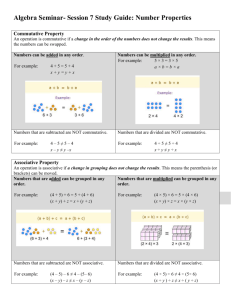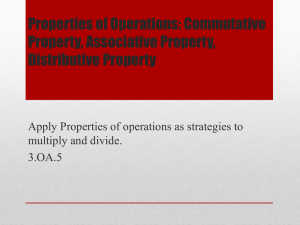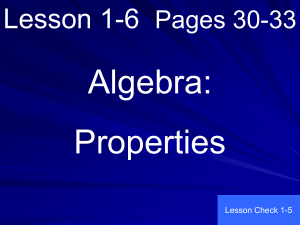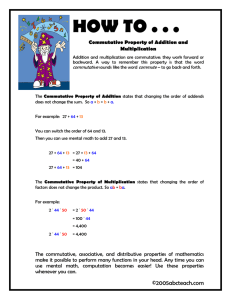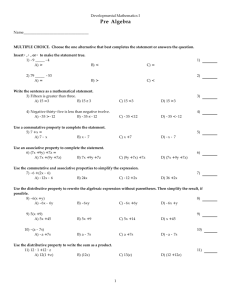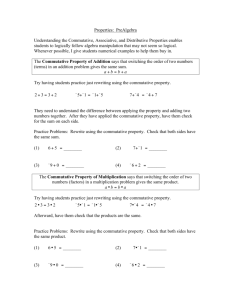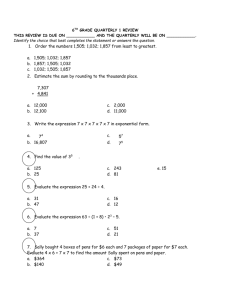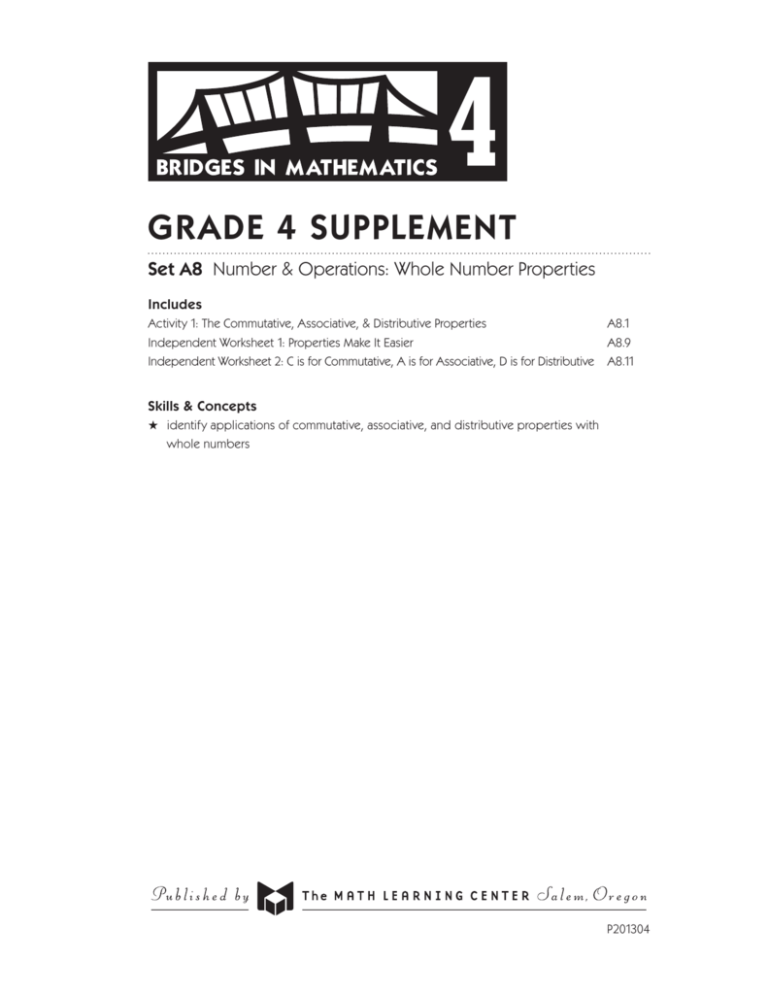
GRADE 4 SUPPLEMENT
Set A8 Number & Operations: Whole Number Properties
Includes
Activity 1: The Commutative, Associative, & Distributive Properties A8.1
Independent Worksheet 1: Properties Make It Easier
A8.9
Independent Worksheet 2: C is for Commutative, A is for Associative, D is for Distributive A8.11
Skills & Concepts
H identify applications of commutative, associative, and distributive properties with
whole numbers
P201304
Bridges in Mathematics Grade 4 Supplement
Set A8 Number & Operations: Whole Number Properties
The Math Learning Center, PO Box 12929, Salem, Oregon 97309. Tel. 1 800 575–8130.
© 2013 by The Math Learning Center
All rights reserved.
Prepared for publication on Macintosh Desktop Publishing system.
Printed in the United States of America.
P201304
The Math Learning Center grants permission to classroom teachers to reproduce blackline
masters in appropriate quantities for their classroom use.
Bridges in Mathematics is a standards-based K–5 curriculum that provides a unique blend
of concept development and skills practice in the context of problem solving. It incorporates the Number Corner, a collection of daily skill-building activities for students.
The Math Learning Center is a nonprofit organization serving the education community.
Our mission is to inspire and enable individuals to discover and develop their mathematical
confidence and ability. We offer innovative and standards-based professional development,
curriculum, materials, and resources to support learning and teaching. To find out more,
visit us at www.mathlearningcenter.org.
Set A8 Number & Operations: Whole Number Properties
Set A8 H Activity 1
ACTIVITY
The Commutative, Associative, & Distributive Properties
Overview
You’ll need
Although students often use the commutative, associative,
and distributive properties to solve problems, they may
not know the properties by name. This activity introduces
the properties in the context of mental math.
H Equations & Properties (pages A8.5 and A8.6, run a
copy of each sheet on a transparency)
Skills & Concepts
H overhead pens
H identify applications of commutative, associative, and
distributive properties with whole numbers
H Defining & Using the Properties (page A8.7, run a class set)
H paper to mask parts of the overhead
Advance Preparation Before you conduct this activity,
write the terms Commutative Property, Associative Property, and Distributive Property on the board.
Instructions for The Commutative, Associative, & Distributive Properties
1. Draw students’ attention to the terms you have written on the board. Read them together. Ask volunteers to share anything they know about these terms.
2. Explain that even if these terms don’t sound very familiar, students may know more about them than
they think. Each of the properties you have listed has to do with the way numbers behave, and today,
you are going to investigate these behaviors together.
3. Place Equations and Properties on the overhead. Before you turn on the projector, cover the entire
transparency with a piece of paper. Explain that when you turn on the projector, students will each
think privately about the problem they see and raise their hand when they have the answer. Then turn
on the projector and move the paper to reveal problem 1.
Set A8 Number & Operations: Whole Number Propert es Blackl ne Run one copy on a transparency
Equations & Properties page 1 of 2
1
Solve this problem in your head: 5 × 37 × 2 =
4. When most hands are up, ask students to pair-share their solutions and strategies. Then call on several volunteers to share their thinking with the class.
Students It’s 370. At first I thought it was hard. Then I realized I could just multiply
5 × 2. That’s 10, and 10 × 37 is 370.
I got the same thing. I was going to round 37 up to 40, but then I saw 5 × 2.
© The Math Learning Center
Bridges in Mathematics Grade 4 Supplement • A8.1
Set A8 Number & Operations: Whole Number Properties
Activity 1 The Commutative, Associative, & Distributive Properties (cont.)
5. Chances are, at least some students will report that they switched the order of the numbers, perhaps
mentally reversing the position of 37 and 2 to make the problem read 5 × 2 × 37. Is this okay? Is it true
that 37 × 2 is the same as 2 × 37? Ask students to talk with one another about this issue, and then invite volunteers to defend the move.
Students Sure it’s okay. You can switch numbers when you multiply. Like 3 × 4 is the same as
4 × 3, right?
You can do that when you add, too. 7 + 3 is 10, but so is 3 + 7.
6. Reveal the rest of the overhead one section at a time. Read and discuss the steps with your students
to explain that when reformulating 5 × 37 × 2 to make it easier to solve mentally, you actually need to
use both the associative and the commutative properties. Together, these two properties let you add or
multiply a string of numbers in any order.
Set A8 Number & Operations: Whole Number Propert es Blackl ne Run one copy on a transparency
Equations & Properties page 1 of 2
1
Solve this problem in your head: 5 × 37 × 2 =
Order of operations says we multiply the numbers in order from left to right:
(5 × 37) × 2
We can use two properties to make this problem easier to solve:
Associative Property
Changing the way you group three numbers or numerical epressions when you add or
multiply does not change the answer. (2 + 3) + 4 = 2 + (3 + 4) and (2 × 3) × 4 =
2 × (3 × 4)
(5 × 37) × 2 = 5 × (37 × 2)
Commutative Property
Changing the order of two numbers or numerical epressions when you add or multiply
does not change the answer. 5 + 3 = 3 + 5 and 3 × 4 = 4 × 3
5 × (37 × 2) = 5 × (2 × 37)
If we use the associative property again, we can make the problem even easier to
solve.
5 × (2 × 37) = (5 × 2) × 37
10 × 37 =
What’s the answer?
7. Use the second overhead to introduce the distributive property. When you have reviewed all three
properties, ask students to identify which one(s) is/are most helpful in solving each of the four problems
at the bottom of the second overhead.
A8.2 • Bridges in Mathematics Grade 4 Supplement
© The Math Learning Center
Set A8 Number & Operations: Whole Number Properties
Activity 1 The Commutative, Associative, & Distributive Properties (cont.)
Set A8 Number & Operations: Whole Number Propert es Blackl ne Run one copy on a transparency
Equations & Properties page 2 of 2
2
Solve this problem in your head: 6 × 17 =
Did you multiply 6 × 10 and then 6 × 7, and then add the two products? If you
did, you used the
Distributive Property
When you multiply a number you can break that number apart. Multiply each part
separately, and then add the products. You will still get the same answer.
6 × 17 = 6 × (10 + 7)
6 × (10 + 7) = (6 × 10) + (6 × 7)
(6 × 10) + (6 × 7) = 60 + 42
60 + 42 =
What’s the answer?
3
Solve the problems below in your head. Use one or more of the
properties to help?
Commutative Property Switch the order of two numbers.
Associative Property Group it differently.
Distributive Property Break the number apart and multiply one part at a time.
a
(28 × 50) × 2 =
b
(40 + 267) + 60 =
c
5 × 37 =
d
4 × (25 × 298) =
8. Next, give students each a copy of Defining and Using the Properties. Review the sheet with the class
and provide clarification as needed. When students understand what to do, let them go to work. Encourage them to share their thinking with others nearby as they work.
Set A8 Number & Operations: Whole Number Properties Blackline Run a class set
NAME
DATE
Defi ning & Using the Properties
1 Write your own definition of each property, and give an example so you can
remember how it works.
Property
a
Commutative
b
Associative
c
Distributive
Defi nition
Example
2
For each problem below:
Use one or more of the above properties to rewrite the equation in a form
that’s easier to solve.
• Solve it and write the answer.
• Circle all the properites you used to rewrite the equation (C for commutative,
A for Associative, and D for Distributive.)
•
Problem
ex. (70 + 469) +30
Answer
569
Property
C
A
D
a (5 × 39) × 2
C
A
D
b
(27 × 25) × 4
C
A
D
c
4 × 27
C
A
D
d (40 + 579) + 60
C
A
D
e
6 × 28
C
A
D
(16 × 50) × 2
C
A
D
f
© The Math Learning Center
Rewrite
(70 + 30) +469
Bridges in Mathematics Grade 4 Supplement • A8.3
Set A8 Number & Operations: Whole Number Properties
Activity 1 The Commutative, Associative, & Distributive Properties (cont.)
Extension
• Consider doing the following Factor Puzzles activity with some or all of your students. Write 12 × 25
= 75 × 4 on the overhead and ask students to help you prove this statement is true by using factoring and the commutative and associative properties. Can they start with 12 × 25 and help you take
whatever steps are necessary to transform 12 × 25 into 75 × 4? List the steps students advise you to
take on the overhead. After they are finished you could also go back and label each step taken with
F (factoring), C (using the commutative property) or A (using the associative property), again, as advised by students.
Students I see what to do… Turn 12 into 3 × 4 and write 3 × 4 × 25.
Then have the 4 and the 25 switch places.
Then you can put the 3 and the 25 together because they’ll multiply to make 75.
12 × 25
(3 × 4) × 25 3 × (4 × 25) 3 × (25 × 4)
(3 × 25) × 4
75 × 4
F (factoring)
A (associative factor)
C (commutative property)
A (associative property)
Next, have students advise you on the steps required to prove that 5 × 100 = 10 × 50.
5 × 100
5 × (10 × 10)
(5 × 10) × 10
(10 × 5) × 10
10 × (5 × 10)
10 × 50
F (factoring)
A (associative)
C (commutative)
A (associative)
Now write the following statements on the whiteboard or overhead:
4 × 50 = 5 × 40
12 × 25 = 6 × 50
25 × 16 = 20 × 20
30 × 20 = 60 × 10
Ask student pairs to choose any two of these statements, write them in their journals and prove they
are true by using factoring and the commutative and associative properties of multiplication. (All the
expressions require factoring but some might involve only one of the properties, depending on how
students order the factors.) If your students enjoy these puzzles, you might make up some more or
ask interested children to create additional puzzles for their classmates.
INDEPENDENT WORKSHEET
Use Set A8 Independent Worksheets 1 and 2 to provide students with more practice identifying applications of the commutative, associative, and distributive properties with whole numbers.
A8.4 • Bridges in Mathematics Grade 4 Supplement
© The Math Learning Center
Set A8 Number & Operations: Whole Number Properties Blackline Run one copy on a transparency.
Equations & Properties page 1 of 2
1
Solve this problem in your head: 5 × 37 × 2 =
Order of operations says we multiply the numbers in order from left to right:
(5 × 37) × 2
We can use two properties to make this problem easier to solve:
Associative Property
Changing the way you group three numbers or numerical epressions when you add or
multiply does not change the answer. (2 + 3) + 4 = 2 + (3 + 4) and (2 × 3) × 4 =
2 × (3 × 4)
(5 × 37) × 2 = 5 × (37 × 2)
Commutative Property
Changing the order of two numbers or numerical epressions when you add or multiply
does not change the answer. 5 + 3 = 3 + 5 and 3 × 4 = 4 × 3
5 × (37 × 2) = 5 × (2 × 37)
If we use the associative property again, we can make the problem even easier to
solve.
5 × (2 × 37) = (5 × 2) × 37
10 × 37 =
What’s the answer?
© The Math Learning Center
Bridges in Mathematics Grade 4 Supplement • A8.5
Set A8 Number & Operations: Whole Number Properties Blackline Run one copy on a transparency.
Equations & Properties page 2 of 2
2
Solve this problem in your head: 6 × 17 =
Did you multiply 6 × 10 and then 6 × 7, and then add the two products? If you
did, you used the
Distributive Property
When you multiply a number you can break that number apart. Multiply each part
separately, and then add the products. You will still get the same answer.
6 × 17 = 6 × (10 + 7)
6 × (10 + 7) = (6 × 10) + (6 × 7)
(6 × 10) + (6 × 7) = 60 + 42
60 + 42 =
What’s the answer?
3
Solve the problems below in your head. Use one or more of the
properties to help?
Commutative Property Switch the order of two numbers.
Associative Property Group it differently.
Distributive Property Break the number apart and multiply one part at a time.
a
(28 × 50) × 2 =
b
(40 + 267) + 60 =
c
5 × 37 =
d
4 × (25 × 298) =
A8.6 • Bridges in Mathematics Grade 4 Supplement
© The Math Learning Center
Set A8 Number & Operations: Whole Number Properties Blackline Run a class set.
NAME
DATE
Defining & Using the Properties
1
Write your own definition of each property, and give an example so you can
remember how it works.
Property
a
Commutative
b
Associative
c
Distributive
Definition
Example
2 For each problem below:
• Use one or more of the above properties to rewrite the equation in a form
that’s easier to solve.
• Solve it and write the answer.
• Circle all the properites you used to rewrite the equation (C for commutative,
A for Associative, and D for Distributive.)
Problem
ex. (70 + 469) +30
Rewrite
Answer
(70 + 30) + 469
569
Property
C
A
D
a (5 × 39) × 2
C
A
D
b
(27 × 25) × 4
C
A
D
c
4 × 27
C
A
D
d (40 + 579) + 60
C
A
D
e
6 × 28
C
A
D
f
(16 × 50) × 2
C
A
D
© The Math Learning Center
Bridges in Mathematics Grade 4 Supplement • A8.7
A8.8 • Bridges in Mathematics Grade 4 Supplement
© The Math Learning Center
Set A8 Number & Operations: Whole Number Properties Blackline Use anytime after Set A8, Activity 1. Run a class set.
NAME
DATE
Set A8 H Independent Worksheet 1
INDEPENDENT WORKSHEET
Properties Make It Easier
Here are two properties that make it easier to do mental math.
Commutative Property Changing the order of two numbers or numerical epressions
when you add or multiply does not change the answer.
5 + 3 = 3 + 5 and 3 × 4 = 4 × 3
Associative Property Changing the way you group three numbers or numerical epressions when you add or multiply does not change the answer.
(2 × 3) × 4 = 2 × (3 × 4)
2 For each problem below:
• Use one or both of the above properties to rewrite the equation in a form
that’s easier to solve.
• Solve it and write the answer.
• Circle all the properites you used to rewrite the equation (C for commutative,
A for Associative, or C and A if you used both properties.)
Problem
ex. (70 + 469) +30
Rewrite
Answer
(70 + 30) +469
569
Property
C
A
a (5 × 68) × 2
C
A
b
(24 × 25) × 4
C
A
c
(32 × 50) × 2
C
A
d (40 + 579) + 60
C
A
e
C
A
50 × (20 × 16)
(Continued on back.)
© The Math Learning Center
Bridges in Mathematics Grade 4 Supplement • A8.9
Set A8 Number & Operations: Whole Number Properties Blackline Run a class set
Independent Worksheet 1 Properties Make It Easier (cont.)
Distributive Property When you multiply a number you can break that number
apart. Multiply each part separately, and then add the products. You will still get the
same answer.
2 Use the distributive property to make the problems below easier. Fill in the
missing steps to get the answers.
example
6 × 13
6 x (10 + 3)
a
7 × 23
b
8 × 24
7 × (20 + 3)
8 × (20 + 4)
d
e
5 × 63
h
7 × 39
(6 x 10) + (6 x 3)
60 + 18 = 78
c
5 × 45
3 × 28
(5 × 40) + (5 × 5)
(3 × 20 ) + (3 × 8)
f
g
6 × 35
9 × 24
9 × (20 + 4)
A8.10 • Bridges in Mathematics Grade 4 Supplement
© The Math Learning Center
Set A8 Number & Operations: Whole Number Properties Blackline Use anytime after Set A8, Activity 1. Run a class set.
NAME
DATE
Set A8 H Independent Worksheet 2
INDEPENDENT WORKSHEET
C is for Commutative, A is for Associative, D is for Distributive
1
Draw a line from each property to the correct definition on the right. Write
two more examples below each property to show how it works.
Commutative Property
Associative Property
Distributive Property
Changing the way you group three numbers
when you add or multiply does not change
the answer. (2 × 3) × 4 = 2 × (3 × 4)
You can break a number apart, multiply
each part separately, and then add the
products. You will still get the same answer.
6 × 15 =
6 × (10 + 5) =
(6 × 10) + (6 × 5) =
60 + 30 = 90
Changing the order of two numbers when
you add or multiply does not change the
answer. 5 + 3 = 3 + 5 and 3 × 4 = 4 × 3
2 For each problem below:
• Write it a different way so it’s easier to solve in your head.
• Solve it and write the answer.
• Circle the letter(s) that show(s) the property or properties you used.
Problem
a
Rewrite
Answer
Property
C
A
D
b (4 × 48) × 25
C
A
D
c (60 + 6,532) + 40
C
A
D
d (5 × 456) × 2
C
A
D
e
C
A
D
8 × 32
6 × 85
© The Math Learning Center
Bridges in Mathematics Grade 4 Supplement • A8.11
A8.12 • Bridges in Mathematics Grade 4 Supplement
© The Math Learning Center

